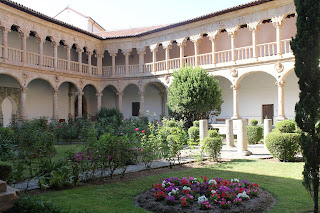Our good old buddy Ángel was off giving other groups the cathedral tour, so we were met instead by Mario. Mario explained a bit about the construction of the two buildings (El Convento de San Esteban, a monastery for Dominican monks, and the other a El Convento de las Dueñas, a convent for nuns), pointing out the different figures that could be seen etched into the front of the monastery building.
Anyway, with that as my basis for understanding of Semana Santa, I was surpised by Mario's description of Salamanca's version of the same observance. Here, the tradition is much more somber, quieter, and smaller. For example, below is an example of one of the monastery's pasos, which is significantly less ornate and flashy that what I remember from Sevilla, although still beautiful:
It was a good reminder that there is more than one way to carry out an idea, and that every place has their own traditions, however similar they may be.
The other interesting point about this trip was the museum area devoted to the indigenous populations of the New World. On one side of the coin, Christopher Columbus had meetings with Queen Isabel here about his plans for travel west. On the other side, Bartolomé de las Casas gave his first sermon here in defense of the rights of (American) Indians in 1511. While Columbus was known for his cruelty among the Indigenous populations, de las Casas was considered one of the first champions of Human Rights. The museum at the monastery houses various artifacts, and the walls are lined with quotes from de las Casas and various other supporters of Indian rights:
All the nation has the right to govern itself.
By natural right, no one is more superior to anyone else.
After leaving the monastery, we paid a brief visit to the convent, where we sat in the beautiful cloisters and then sampled some of the treats made by the nuns.
Then it was time to move along to our first Spanish Cinema class. We were surprised to find that it was taught by none other than Ángel! Over the course of the next hour, he gave us an introduction to the arrival of movie-making technology here in Spain, and we watched a few clips of some of the earliest silent films. In spite of the heat in the classroom, I found the lecture very interesting, and I look forward to the next five sessions.Following Cine class, a few of us decided to go out for tapas. I was hoping for tortilla, but happily settled for two rounds of croquetas (ham, potato, and cream sauce dumplings). By the time we finished and wandered back through the Plaza Mayor, it was all lit up. It was the first time I've seen it that way, and it looked even more beautiful than it does in the day time. It still amazing to me how full of people - of all ages - it was at nearly 11:00 at night.
Now, after a morning of classes, I'm preparing myself for another busy afternoon. We have a tour of the palaces, followed by another Cine class. Then, a few of us have tickets to a show (all included in the cost of our program at the University), which doesn't start until 11:00 at night! I have no idea how I'm going to make it through all of this without falling asleep. Regardless, it should be fun!









No comments:
Post a Comment